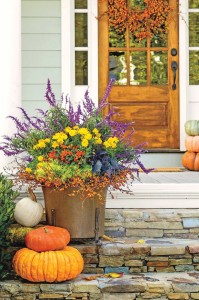Fall’s Focal Point
A break in the weather opens opportunities to continue improving your current landscape.
 As we start to feel relief from summer’s high temperatures there is a renewed interest in caring for our landscapes. While it’s easy to think our flora and fauna will flourish on their own, there are still tasks to take care of that will ensure they thrive through the chillier months. We spoke with local landscaping professionals who offered their insight on maintenance, keeping plants healthy and how Floridians can still enjoy the colors of autumn here in the Sunshine State.
As we start to feel relief from summer’s high temperatures there is a renewed interest in caring for our landscapes. While it’s easy to think our flora and fauna will flourish on their own, there are still tasks to take care of that will ensure they thrive through the chillier months. We spoke with local landscaping professionals who offered their insight on maintenance, keeping plants healthy and how Floridians can still enjoy the colors of autumn here in the Sunshine State.
Typical Tasks
Every season brings its own set of steps for maintenance, and in the fall, many of our plants and flowers are still growing. Cleaning up fallen or dead leaves not only helps with the look of a landscape, but can help roots breathe.
“Without the summer heat, the ground can have trouble drying out, especially in the shade; whereas this can cause fungus and disease issues with roots staying too wet,” says Jeff Rouse, owner/operator of Quality by Design Landscaping LLC. For this reason, he recommends not mulching. “Instead of mulching, rake decomposing leaves and debris from under plants and allow them to dry and breathe. This will make it easier to mulch in the spring because there won’t be so much to clear out.”
Another way to ensure the ground around plants dries is not to over-water. It’s a common mistake seen by Rusty Woodall, owner of City Beautiful Landscaping. “Cooler weather and shorter days slow down a plant’s growth and need for water,” he says. “It is better to water only when a plant is in need. Learn the signs, feel the soil. Water infrequently and water deep to get into the root system. Frequent, light watering promotes shallow roots.”
Homeowners should also pay attention to how much sun or shade the landscape is getting. “A damp shaded area is different than a wide open space,” says Rouse. “Controlling the amount of water is especially critical this time of year if a zone is shared by a bright, sunny area as well as a wet, shaded area.” He recommends irrigating once a week in hot, dry weather and not at all if it’s been rainy.
Fertilization can also help further root strength. “You don’t want to promote new growth, but a fertilizer that is lower in nitrogen can promote root health through the winter,” says Woodall. Other tasks he recommends include weeding and mowing the lawn a bit higher during the winter, which can help insulate from a potential frost.
Freshening Up
Perhaps you’ve grown a little tired of your current landscaping arrangements or you’ve been thinking about finally investing in that outdoor kitchen project. Well, fall is as good a time as any to make it happen.
“Complete landscaping renovations are just as popular in the fall as they are in spring here in Central Florida,” says Rouse. “Schools are back in session, summer vacations are over and the holidays are still far enough off that you have a perfect window. If you do it now, you’ll have an established look in time for the holidays.”
In fact, much like other areas of the country, fall is one of the best times for new trees and shrubs. “Without the high heat and [rain], plants have time to establish good root systems before the stress of next summer,” says Woodall.
For flowers, Woodall recommends petunias, pansies, snap dragons and geraniums—his personal favorite—as well as winter vegetables. “Check your garden center to see what they have ready to plant or start from seeds,” he says, naming beets, Brussels sprouts, carrots and onions.
And if you’re craving those classic warm autumnal colors—especially transplants from other parts of the country—there are plenty of ways to create a familiar fall look.
“Although here in Florida we don’t have the full four seasons, we can find plants with the colors or elements of fall,” says Rouse. “Crotons have a Florida fall look; also marigolds with the yellow and orange mix of colors. Mums are always a favorite. Fountain and [ornamental] grasses, like muhly grass, have a plume that resembles cattails or a dried out corn husk, which are popular in fall displays.”
A decorative pot arrangement on a home’s front entryway offers versatility throughout the year. Rouse continues: “This time of year, a decorative pot arrangement works well because the colors can be rotated to work for fall, Halloween and Thanksgiving, and then changed for December’s holiday season at a very minimal cost and creates a beautiful focal point feature or landscape item.”












